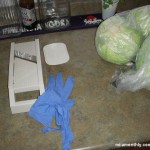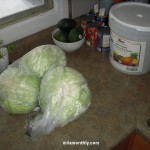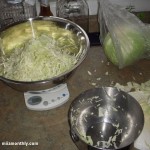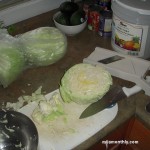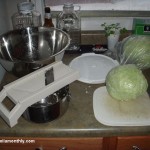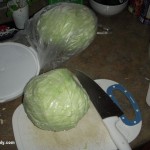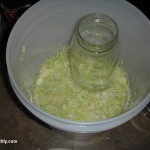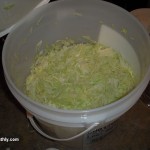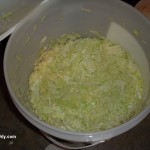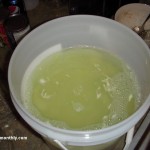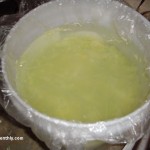This is one of those strange projects that I’ve wanted to try for a very long time. Somehow an email chain was started in my clique, about one of them being on a cabbage fix lately. Since that chain email planted the cabbage seed in my head. When I ended up going to the grocery store this past weekend, they just happen to have cabbage for $0.33 a lb. Three heads of cabbage and 10 lbs later I was off and running with this sauerkraut experiment.
I used a couple different web sites (links at the bottom) as a starting point for the recipe, and they basically all repeated the same cabbage to salt formula. With the formula being 5 lbs (80 oz) of shredded cabbage to 3 TB (45 mL) canning/pickling salt.
Since I had more then 5 lbs of cabbage, after a little bit of math here is the recipe that I ended up with:
- 109.1 oz ( 6 lbs & 13.1 oz ) Shredded green cabbage (outer leaves and cores removed)
- 63ml (just over 4 TB & 1/2 tsp) Morton canning/pickling salt
- Brine strength – 2 TB canning salt per 1 qt water
The process couldn’t be more straight forward in dealing with the cabbage. Rinse the outside of the cabbage and peel away the outer leaves of the head. Then quarter the head of cabbage, leaving the core in place to keep the cabbage together. Take the quarters and shred on a mandolin, then toss the shredded cabbage with salt.
Pack the salted cabbage down into your fermenting container. I used an old food service bucket that once had raspberry jelly filling for the fermenting container, and I packed down the cabbage with an empty canning jar. Now that everything is packed down in the bucket, let it sit for 10-15 minutes to let the salt draw out the natural juices from the cabbage. Also while the cabbage is sitting in the bucket, you can give it a couple of turns so that the salt is evenly distributed through out the cabbage.
After the 15 minutes have passed, more then likely you only have about a ½” of cabbage juice at the surface, so you’ll need to add brine solution so that it covers the cabbage with about 1” to 2” inches of brine. Finally add a dinner/salad plate to the top of the cabbage, to keep the cabbage from floating to the surface. And cover the top surface of the brine with a piece of plastic (bag or sheet) that is filled with brine (the plastic cover helps to reduce the formation of surface scum/bloom.)
Now just put the container is a warm place (from 60F to 75F) and let nature do its magic. About everyday or so check the fermentor to see if any scum is forming under the plastic sheet. If scum is forming, just remove the plastic, skim the scum and clean off the plastic. Then just put the plastic back into the bucket in reverse order. And in about 3-4 weeks per the multitude of recipes, the sauerkraut should be all done fermenting and ready to eat.
Side note:
- When I talked with my mom about making sauerkraut, she asked me if I had added any carrots to the mix. With the explanation being that the carrots took away some of the bitterness of the cabbage. Since I had never heard of this before, I didn’t do it on this batch. But if I end up making another batch of sauerkraut, I’ll be adding carrots to test this “Old Country” wisdom out.
- I had two separate bowls for shredding the cabbage. One bowl was used to collect the shredded cabbage from the mandolin. The other bowl was on the digital scale to measure the amount of cabbage that was shredded, and for salting the cabbage.
- I used brewing sanitizer (5 star Star San) to spray down everything (the bucket and lid, plastic cover, tools, etc.), just so that the cabbage could have a solid start fermenting.
- Like I mentioned I used a mandolin to shred the cabbage, but if you have a Cuisinart with a shredding disk, it will make the shredding task go a lot quicker.
- The only really big difference that I noticed between all the recipes, was brine strength. A couple of sites had 1.5 TB salt to 1 qt water, while others had 2 TB salt to 1 qt water. Just to be on the safe side I went with 2 TB salt to 1 qt water.
These are the three recipe/techniques that were referenced to make this sauerkraut:
National Center for Home Food Preservation
Wild Fermentation
University of Wisconsin Extension
